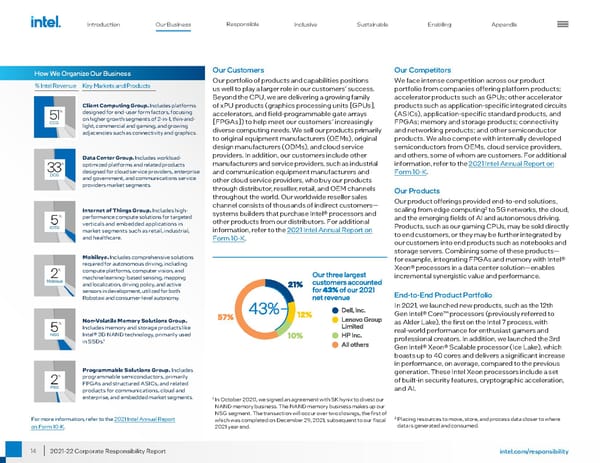14 intel.com/responsibility 2021-22 Corporate Responsibility Report How We Organize Our Business % Intel Revenue Key Markets and Products Client Computing Group. Includes platforms designed for end-user form factors, focusing on higher growth segments of 2-in-1, thin-and- light, commercial and gaming, and growing adjacencies such as connectivity and graphics. Data Center Group. Includes workload- optimized platforms and related products designed for cloud service providers, enterprise and government, and communications service providers market segments. Internet of Things Group. Includes high- performance compute solutions for targeted verticals and embedded applications in market segments such as retail, industrial, and healthcare. Mobileye. Includes comprehensive solutions required for autonomous driving, including compute platforms, computer vision, and machine learning- based sensing, mapping and localization, driving policy, and active sensors in development, utilized for both Robotaxi and consumer-level autonomy. Non-Volatile Memory Solutions Group. Includes memory and storage products like Intel® 3D NAND technology, primarily used in SSDs. 1 Programmable Solutions Group. Includes programmable semiconductors, primarily FPGAs and structured ASICs, and related products for communications, cloud and enterprise, and embedded market segments. Our Customers Our portfolio of products and capabilities positions us well to play a larger role in our customers ’ success. Beyond the CPU, we are delivering a growing family of xPU products (graphics processing units [GPUs], accelerators, and field-programmable gate arrays [FPGAs]) to help meet our customers ’ increasingly diverse computing needs. We sell our products primarily to original equipment manufacturers (OEMs), original design manufacturers (ODMs), and cloud service providers. In addition, our customers include other manufacturers and service providers, such as industrial and communication equipment manufacturers and other cloud service providers, who buy our products through distributor, reseller, retail, and OEM channels throughout the world. Our worldwide reseller sales channel consists of thousands of indirect customers— systems builders that purchase Intel® processors and other products from our distributors. For additional information, refer to the 2021 Intel Annual Report on Form 10-K . Our Competitors We face intense competition across our product portfolio from companies offering platform products; accelerator products such as GPUs; other accelerator products such as application-specific integrated circuits (ASICs), application-specific standard products, and FPGAs; memory and storage products; connectivity and networking products; and other semiconductor products. We also compete with internally developed semiconductors from OEMs, cloud service providers, and others, some of whom are customers. For additional information, refer to the 2021 Intel Annual Report on Form 10-K . Our Products Our product offerings provided end-to-end solutions, scaling from edge computing 2 to 5G networks, the cloud, and the emerging fields of AI and autonomous driving. Products, such as our gaming CPUs, may be sold directly to end customers, or they may be further integrated by our customers into end products such as notebooks and storage servers. Combining some of these products— for example, integrating FPGAs and memory with Intel® Xeon® processors in a data center solution—enables incremental synergistic value and performance. End-to-End Product Portfolio In 2021, we launched new products, such as the 12th Gen Intel® Core™ processors (previously referred to as Alder Lake), the first on the Intel 7 process, with real-world performance for enthusiast gamers and professional creators. In addition, we launched the 3rd Gen Intel® Xeon® Scalable processor (Ice Lake), which boasts up to 40 cores and delivers a significant increase in performance, on average, compared to the previous generation. These Intel Xeon processors include a set of built-in security features, cryptographic acceleration, and AI. For more information, refer to the 2021 Intel Annual Report on Form 10-K . 1 In October 2020, we signed an agreement with SK hynix to divest our NAND memory business. The NAND memory business makes up our NSG segment. The transaction will occur over two closings, the first of which was completed on December 29, 2021, subsequent to our fiscal 2021 year end. 2 Placing resources to move, store, and process data closer to where data is generated and consumed. Introduction Responsible Inclusive Sustainable Enabling Appendix Our Business
 Intel Corporate Responsibility Report Page 13 Page 15
Intel Corporate Responsibility Report Page 13 Page 15